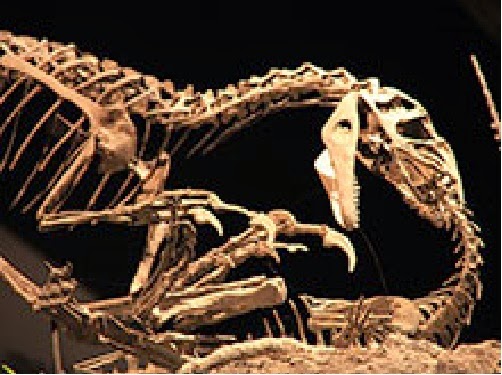
Scientists have used a highly sensitive, high-resolution X-ray scanning technique to detect minute quantities of chemicals associated with bone healing in 150-million-year-old dinosaur bones.
They looked in cracks, fractures and breaks in the ancient remains, and found traces of copper, zinc and strontium, which are essential for enzymes involved with bone maintenance, repair and healing.
As well as shedding light on the differences between normal and healed bone, the findings give the first chemical clues to how the dinosaurs’ bones may have healed when they were injured.
They also suggest that many predatory dinosaurs may have recovered from the impact of massive trauma, which would likely kill you or me.
The findings are published in Journal of the Royal Society Interface.
‘It seems dinosaurs evolved a splendid suite of defence mechanisms to help regulate the healing and repair of injuries. Not a lot is known about the biochemistry of healing in extinct animals. So, the ability to diagnose such processes some 150 million years later might well shed light on how we can use Jurassic chemistry in the 21st century,’ says Dr Phil Manning of the University of Manchester, one of the study’s co-authors.
Fossilised bones sometimes show evidence of trauma, sickness and subsequent signs healing. Working out what happened to them usually relies on scientists slicing through ancient, valuable specimens to analyse them.
Manning and colleagues from UK and US universities realised that looking at so-called chemical signatures in the bones could uncover details about how they healed.
‘This is because the body uses a distinct suite of trace-metal co-ordinated enzymes to repair bones,’ explains Manning.
‘Copper-based enzymes are associated with forming calluses. The second stage of bone repair involves zinc-containing enzymes, which promotes bone growth. And the final stage to check all the work done is good involves an enzyme that contains strontium,’ he adds.
‘So if you’re imaging a healed fracture, you’ll find trace amounts of strontium evenly distributed along the healed bone. But if it’s still healing, there’ll be higher concentrations of zinc.’
These elements make up much less than one per cent of our entire bodies, which means trying to find them in 150-million-year-old fossils is a big ask.
The interdisciplinary team based at the University of Manchester used both the Stanford Synchrotron Radiation Light Source and Diamond Light Source to analyse a bone from a theropod dinosaur called Allosaurus fragilis.
The predatory Allosaurus, which means ‘different lizard’, lived 155 to 150 million years ago during the late Jurassic Period. It was a member of a group of vertebrates called the archosaurs, whose modern members include the crocodiles and birds.
The researchers also used the Stanford synchrotron to analyse a bone from a living archosaur, the turkey vulture.
‘Theropods are a logical study group as they are more closely related to the most diverse group of extant archosaurs, the birds,’ explain the authors.
Synchrotron particle accelerators act like a giant microscope, harnessing the power of electrons to produce light brighter than a billion suns to study anything from jet engines to viruses and vaccines.
The team used extremely bright light produced by the two particle accelerators to find minute traces of zinc, copper and strontium in the bones.
‘You can only detect such chemistry using a synchrotron, because this technique permits you to exactly image the relationship of each atom to its surrounding elements. This allows you to identify if the element was part of the bone-healing process, or if it came from the environment in which the bone became fossilised,’ says Manning.
When they compared the chemical signatures in the dinosaur and turkey vulture specimens, they expected them to be fairly similar.
But they found that the dinosaur bone revealed signs of fracture healing that are more reminiscent of that of modern reptiles like crocodiles or alligators.
‘It is quite possible you’ve got a reptilian-style repair mechanism combined with elevated metabolism, like that you’d find in alligators and birds respectively. So you’ve got a double whammy in a good way. If you suffer massive trauma, you’ve got the perfect set-up to survive it,’ says Manning.
‘Bones doesn’t form scar tissue, like a scratch to your skin, so the body has to completely reform new bone following the same stages that occurred at the skeleton grew in the first place. The means we are able to tease out the chemistry of bone development through such pathological studies,’ says Jennifer Anné, PhD student at the University of Manchester, first author of the study.
‘You’re basically seeing a biological process preserved in the sands of time,’ adds Manning.
More Information :
Jennifer Anné, Nicholas P. Edwards, Roy A. Wogelius, Allison R. Tumarkin-Deratzian, William I. Sellers, Arjen van Veelen, Uwe Bergmann, Dimosthensis Sokaras, Roberto Alonso-Mori, Konstantin Ignatyev, Victoria M. Egerton and Phillip L. Manning, Synchrotron imaging reveals bone healing and remodelling strategies in extinct and extant vertebrates, Journal of the Royal Society Interface, published 7th May 2014, http://dx.doi.org/10.1098/rsif.2014.0277
Note : The above story is based on materials provided by © Natural Environment Research Council










